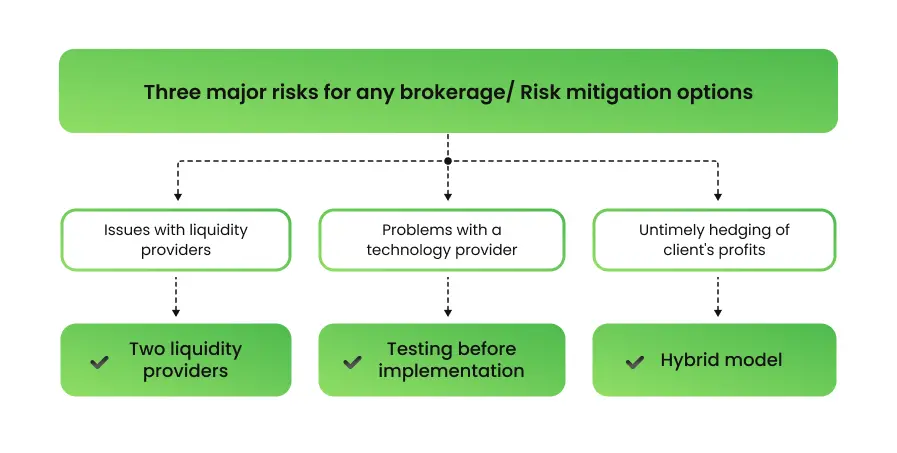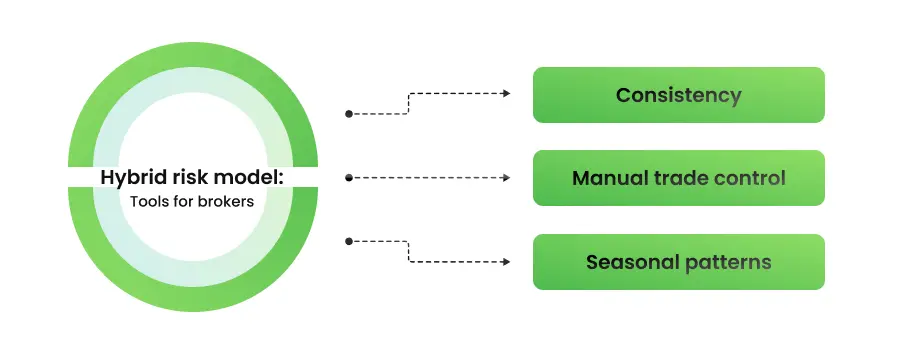What do you need to know about Forex brokerage risk management to become almost bulletproof
- Three major risks for any brokerage
- Popular risk models: a broker’s outlook
- Hybrid risk model: navigating the client patterns
- Keeping liquidity providers happy
- Final thoughts
As a rule, when it comes to risk management in brokerage firms, it is customary to mention only the subject of choosing between the A-book and B-book. And although the issue of liquidity is pivotal, the set of risk mitigation procedures includes other equally important aspects. We will consider them in this publication and try to derive some guidelines that will help to apply these principles correctly.
Three major risks for any brokerage
Regardless of the chosen brokerage business model, there are three main risks that any FX broker will have to deal with. Please keep in mind that these risks are relevant to established businesses that have all the attributes of a full-fledged brokerage, and not just the name.

Issues with liquidity providers
The broker's money is always on the side of the liquidity provider, so we can say that the relationship between the provider and the broker is unequal, and the problem with liquidity originates from this imbalance. In case a provider wants to profit more and widen the spread a little bit, for example, that would automatically deteriorate the situation for your clients. Also, with complete dependence on one provider, any problems on their side, as if financial or technical, will extend to a brokerage. Also, keep in mind that changing providers is not a quick process, and the procedure can take up to three months.
Risk mitigation options.
The situation where a contemporary brokerage holds only one liquidity provider for an asset class is unacceptable. Any asset that is offered to clients must be backed by at least two liquidity providers.
Problems with a technology provider
Not all brokers have the resources to maintain a large staff of developers and technical specialists. Very often companies use the services of contractors who develop new back-office functionality, connections to payment systems, bridges, and connectors. In this case, you become technologically dependent, and it will be very difficult to change the provider of the corresponding services if the need arises.
Risk mitigation options.
It is necessary to be as responsible as possible in choosing a provider of technological solutions and to check every word of the sales manager during negotiations. Also, any potential changes to the architecture and new solutions must be tested before implementation.
Untimely hedging of client's profits
Every client wants to make money, and that's why traders initially come to brokers. This, however, begs the question of the proper handling of performing clients, so that sudden, unexpected market movements do not put the company out of business altogether. In this case, the approach to risk management in brokerage firms (A-book, B-book, hybrid), as well as the correct assessment of the client behavior, comes to the fore.
Risk mitigation options.
The best option for any modern broker would be to resort to a hybrid model, which combines features of A-book and B-book. We will talk about this in more detail in the next section.
Popular risk models: a broker’s outlook
Let's start by taking a closer look at the A-book, B-book, and hybrid Forex broker business models, and highlighting their main features and differences from the broker's perspective.
A-book
First of all, let’s talk about what is an A-book broker in Forex. The definition of the A-book model is a brokerage operation scheme that transmits all client trades directly to the interbank market. Thus, the broker acts only as an intermediary, while the market acts as a counterparty. The broker's income consists of markups and commission.
The main advantages of this option are that the results of clients' trading do not carry any risks for the broker, on the contrary, the latter can profit from the trading turnover. Thus, it is advantageous for the broker that a client trades as long as possible and does not lose their money, which is why many traders consider A-book brokers to be more reliable or profitable. One more advantage of such an approach is the lower cost of the license and simplified regulation conditions. Now it matters a lot because traders tend to choose brokers with the regulation in well-known jurisdictions, and offshore companies without regulation lose clients and trust.
B-book
Now, let’s talk about what is a B-book broker. The B-book or market maker (MM) is a model of risk management in brokerage firms, where the broker serves as a liquidity provider for a client transaction that does not reach the interbank. Unlike A-Book, the FX B-book model does not imply overlapping trades via liquidity providers. Thus, a B-book broker bears the responsibility to the client with their own funds, i.e. the client's profit is the broker's loss and vice versa.
There are several important drawbacks that make it very difficult to find a pure FX B-book broker in the market right now. Because of the conflict of interest, customer confidence in such brokerage businesses is greatly diminished. Moreover, note that an MM broker's license in a well-known, non-offshore jurisdiction will require a hefty sum as a security deposit. Also, a regulator will require detailed reports, which will entail additional costs.
However, the FX B-book model does have advantages that can be used to a brokerage’s benefit without harming their customers. They are accounted for in the hybrid model, which combines the strengths of the A-book and B-book.
Hybrid model
Hybrid Forex brokers have the ability to decide where to send profitable trades, to liquidity providers or to internal execution. The flow of profitable trades, which is usually sent to liquidity providers, is commonly referred to as toxic.
When a liquidity provider notices a blatantly toxic flow, they can degrade execution quality for that broker. This can affect traders in the form of frequent slippages. To avoid this, it’s imperative to analyze the flow of trades and develop certain mechanisms for handling profitable clients. We will discuss this below.
Also, the right technical tools can help a risk manager to maintain the right balance between internal and external liquidity. For example, Forex Broker Turnkey from Soft-FX is an off-the-shelf solution that includes the trading multiplier system, where each trading account on the platform can be assigned a trading multiplier. The value of this multiplier determines the percentage of the requested trading volume that goes to the external market. This feature helps mitigate the possibility of exposure toxic flows to liquidity providers, while effectively hedging risks.
Hybrid risk model: navigating the client patterns
A hybrid online brokerage business model will be the ultimate tool for any broker, as long as the risk manager has a balanced and analytical approach to the evaluation of client trades. The experience of multiple brokers suggests several attributes that characterize potentially profitable clients.

Consistency
A quality risk manager ought to be able to distinguish between a consistent strategy and regular gambling. Emotional and impulsive styles can be distinguished by the frequency and volume of trades, and such clients are often left to internal execution. If a systemic pattern is observed, especially the pattern that already showed positive results, it is advisable to hedge such trades.
Manual trade control
As a rule, Expert Advisors are quite predictable for experienced risk managers in their behavior and profitability. In contrast, accounts that show signs of a strategic approach and manual trade management are worth considering for hedging in a mid or long period because the gain can be unpredictably high.
Seasonal patterns
Many experienced traders have periods when the success of their strategy coincides with the phase of the market, that is, with any fundamental changes. Such events should be monitored especially carefully because the accounts of these clients are the first in the queue for hedging.
Keeping liquidity providers happy
When a risk manager has correctly singled out and hedged the profitable clients, another challenge is to make sure that liquidity providers do not cut off flows of these traders as toxic. Simple math shows that the more liquidity providers you have, the easier it will be to distribute flows from profitable clients. For example, in case a provider is unhappy with a certain flow, the risk manager can simply worsen that provider's prices for the trader who generates that flow.
Also, the employee responsible for robust broker risk management in the brokerage business should stand ready to negotiate with liquidity providers and defend price values at the time of execution in a disputed situation.
Also, having the right software will allow you to use external liquidity to hedge B-book risks in a Forex hybrid model without jeopardizing relationships with providers. For example, the TickTrader Liquidity Aggregator allows you to hedge a minimum percentage of trades (down to nano lots) of any clients from external providers. In this case, trades are executed only after confirmation of the price by a liquidity provider, thus fully securing the broker in case of software failures and delays in price mapping.
Final thoughts: singling out a good risk manager
As the brokerage business experience demonstrates, it is impossible to teach all these patterns from scratch in a couple of months. Such skill comes only with practice, which can only be obtained by an experienced trader. It is not difficult to conduct hedging procedures and drain the clearing account. A definition of a good broker risk management model is a situation when the company profits from both the internal execution and the clearing account.
The Forex Broker Turnkey solution includes all the key components required for effective risk management in Forex brokerage firms. Our team is ready to provide detailed advice on the basics of Forex broker risk management with the help of Soft-FX technologies.



